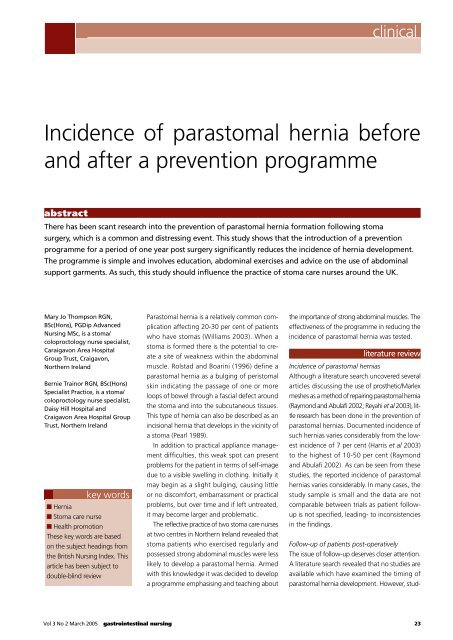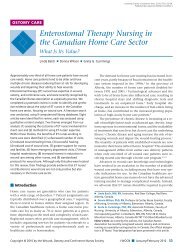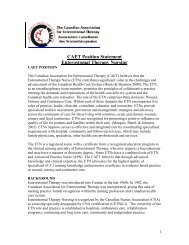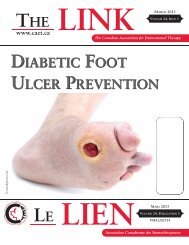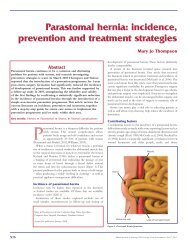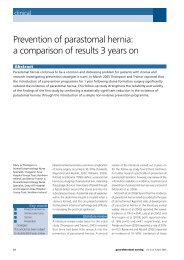Incidence of parastomal hernia before and after a prevention ...
Incidence of parastomal hernia before and after a prevention ...
Incidence of parastomal hernia before and after a prevention ...
Create successful ePaper yourself
Turn your PDF publications into a flip-book with our unique Google optimized e-Paper software.
Parastomal <strong>hernia</strong> is a relatively common complication<br />
affecting 20-30 per cent <strong>of</strong> patients<br />
who have stomas (Williams 2003). When a<br />
stoma is formed there is the potential to create<br />
a site <strong>of</strong> weakness within the abdominal<br />
muscle. Rolstad <strong>and</strong> Boarini (1996) define a<br />
<strong>parastomal</strong> <strong>hernia</strong> as a bulging <strong>of</strong> peristomal<br />
skin indicating the passage <strong>of</strong> one or more<br />
loops <strong>of</strong> bowel through a fascial defect around<br />
the stoma <strong>and</strong> into the subcutaneous tissues.<br />
This type <strong>of</strong> <strong>hernia</strong> can also be described as an<br />
incisional <strong>hernia</strong> that develops in the vicinity <strong>of</strong><br />
a stoma (Pearl 1989).<br />
In addition to practical appliance management<br />
difficulties, this weak spot can present<br />
problems for the patient in terms <strong>of</strong> self-image<br />
due to a visible swelling in clothing. Initially it<br />
may begin as a slight bulging, causing little<br />
or no discomfort, embarrassment or practical<br />
problems, but over time <strong>and</strong> if left untreated,<br />
it may become larger <strong>and</strong> problematic.<br />
The reflective practice <strong>of</strong> two stoma care nurses<br />
at two centres in Northern Irel<strong>and</strong> revealed that<br />
stoma patients who exercised regularly <strong>and</strong><br />
possessed strong abdominal muscles were less<br />
likely to develop a <strong>parastomal</strong> <strong>hernia</strong>. Armed<br />
with this knowledge it was decided to develop<br />
a programme emphasising <strong>and</strong> teaching about<br />
clinical<br />
<strong>Incidence</strong> <strong>of</strong> <strong>parastomal</strong> <strong>hernia</strong> <strong>before</strong><br />
<strong>and</strong> <strong>after</strong> a <strong>prevention</strong> programme<br />
abstract<br />
There has been scant research into the <strong>prevention</strong> <strong>of</strong> <strong>parastomal</strong> <strong>hernia</strong> formation following stoma<br />
surgery, which is a common <strong>and</strong> distressing event. This study shows that the introduction <strong>of</strong> a <strong>prevention</strong><br />
programme for a period <strong>of</strong> one year post surgery significantly reduces the incidence <strong>of</strong> <strong>hernia</strong> development.<br />
The programme is simple <strong>and</strong> involves education, abdominal exercises <strong>and</strong> advice on the use <strong>of</strong> abdominal<br />
support garments. As such, this study should influence the practice <strong>of</strong> stoma care nurses around the UK.<br />
Mary Jo Thompson RGN,<br />
BSc(Hons), PGDip Advanced<br />
Nursing MSc, is a stoma/<br />
coloproctology nurse specialist,<br />
Caraigavon Area Hospital<br />
Group Trust, Craigavon,<br />
Northern Irel<strong>and</strong><br />
Bernie Trainor RGN, BSc(Hons)<br />
Specialist Practice, is a stoma/<br />
coloproctology nurse specialist,<br />
Daisy Hill Hospital <strong>and</strong><br />
Craigavon Area Hospital Group<br />
Trust, Northern Irel<strong>and</strong><br />
key words<br />
■ Hernia<br />
■ Stoma care nurse<br />
■ Health promotion<br />
These key words are based<br />
on the subject headings from<br />
the British Nursing Index. This<br />
article has been subject to<br />
double-blind review<br />
the importance <strong>of</strong> strong abdominal muscles. The<br />
effectiveness <strong>of</strong> the programme in reducing the<br />
incidence <strong>of</strong> <strong>parastomal</strong> <strong>hernia</strong> was tested.<br />
literature review<br />
<strong>Incidence</strong> <strong>of</strong> <strong>parastomal</strong> <strong>hernia</strong>s<br />
Although a literature search uncovered several<br />
articles discussing the use <strong>of</strong> prosthetic/Marlex<br />
meshes as a method <strong>of</strong> repairing <strong>parastomal</strong> <strong>hernia</strong><br />
(Raymond <strong>and</strong> Abulafi 2002; Reyahi et al 2003), little<br />
research has been done in the <strong>prevention</strong> <strong>of</strong><br />
<strong>parastomal</strong> <strong>hernia</strong>s. Documented incidence <strong>of</strong><br />
such <strong>hernia</strong>s varies considerably from the lowest<br />
incidence <strong>of</strong> 7 per cent (Harris et al 2003)<br />
to the highest <strong>of</strong> 10-50 per cent (Raymond<br />
<strong>and</strong> Abulafi 2002). As can be seen from these<br />
studies, the reported incidence <strong>of</strong> <strong>parastomal</strong><br />
<strong>hernia</strong>s varies considerably. In many cases, the<br />
study sample is small <strong>and</strong> the data are not<br />
comparable between trials as patient followup<br />
is not specified, leading- to inconsistencies<br />
in the findings.<br />
Follow-up <strong>of</strong> patients post-operatively<br />
The issue <strong>of</strong> follow-up deserves closer attention.<br />
A literature search revealed that no studies are<br />
available which have examined the timing <strong>of</strong><br />
<strong>parastomal</strong> <strong>hernia</strong> development. However, stud-<br />
Vol 3 No 2 March 2005 gastrointestinal nursing 23
clinical<br />
Figure 1<br />
Abdominal exercises following stoma forming surgery<br />
Pelvic tilting<br />
1. Lie on your back on a firm surface<br />
with knees bent <strong>and</strong> feet flat on the<br />
bed.<br />
2. Pull your tummy in, tilt your<br />
bottom upwards slightly while<br />
pressing the middle <strong>of</strong> your back<br />
into the bed <strong>and</strong> hold for two<br />
seconds<br />
3. Let go slowly<br />
4. Repeat ten times daily.<br />
Knee rolling<br />
1. Lie on your back on a firm surface with<br />
knees bend <strong>and</strong> feet flat on the bed<br />
2. Pull your tummy in <strong>and</strong> keeping<br />
your knees together, slowly roll them<br />
from side to side<br />
3. Repeat ten times.<br />
Abdominal sit ups<br />
1. Lie on your back on a firm surface<br />
with knees bent <strong>and</strong> feet flat on the bed<br />
2. Place your h<strong>and</strong>s on the front <strong>of</strong><br />
your thighs <strong>and</strong> pull your tummy in<br />
3. Lift your head <strong>of</strong>f the pillow<br />
4. Hold for three seconds, then slowly<br />
return to starting position<br />
5. Repeat ten times daily.<br />
Reprinted with kind permission from Respond Plus<br />
ies on the timing <strong>of</strong> development <strong>of</strong> incisional<br />
<strong>hernia</strong>s are available; therefore, as a <strong>parastomal</strong><br />
<strong>hernia</strong> can be equated with an incisional <strong>hernia</strong><br />
(Pearl 1989), these studies were explored to<br />
ascertain the timing <strong>of</strong> <strong>hernia</strong> development.<br />
A seminal study <strong>of</strong> 500 patients with incisional<br />
<strong>hernia</strong>s showed that 67.8 per cent had<br />
developed by one year post surgery (Akman<br />
1962). This finding has implications for the<br />
follow-up <strong>of</strong> stoma patients in the <strong>prevention</strong><br />
<strong>of</strong> <strong>parastomal</strong> <strong>hernia</strong>, suggesting that patients<br />
should be followed for at least one year. In a<br />
separate study, abdominal incisional <strong>hernia</strong>s<br />
developed <strong>before</strong> three months in 57 per cent<br />
<strong>of</strong> patients (Bucknall et al 1982).<br />
Contributing factors<br />
Contributing factors in the incidence <strong>of</strong> a<br />
<strong>parastomal</strong> <strong>hernia</strong> are reported as obesity,<br />
malnutrition, post-operative sepsis, abdominal<br />
distension <strong>and</strong> chronic cough (Pearl 1989).<br />
Other reviews suggest that chest infection,<br />
wound sepsis <strong>and</strong> the ageing process are also<br />
contributing factors (Bucknall <strong>and</strong> Ellis 1984).<br />
A significant correlation exists between wound<br />
<strong>hernia</strong>tion <strong>and</strong> elderly, obese males undergoing<br />
bowel surgery (Bucknall et al 1982).<br />
The association with age may be explained<br />
by the fact that, with increasing age, the rectus<br />
abdominus muscle becomes thinner <strong>and</strong> weaker<br />
<strong>and</strong> is unable to provide adequate support for a<br />
stoma (Williams 2003). However, Williams also<br />
reports that females are more prone to weak<br />
rectus abdominus muscles implying a higher<br />
incidence <strong>of</strong> <strong>parastomal</strong> <strong>hernia</strong>s in this group<br />
which contradicts the findings <strong>of</strong> Bucknall <strong>and</strong><br />
Ellis (1984).<br />
There appears to be no link between technical<br />
factors associated with the construction <strong>of</strong><br />
a stoma such as siting, trephine size, fascial<br />
fixation <strong>and</strong> closure <strong>of</strong> lateral space, <strong>and</strong><br />
stoma <strong>hernia</strong>tion (Carne et al 2003). Yet this<br />
contradicts an earlier study by Sjodahl et al<br />
(1988) which found that stomas constructed<br />
through the rectus abdominus muscle had<br />
a statistically significantly lower incidence <strong>of</strong><br />
<strong>hernia</strong>tion than those constructed lateral to<br />
the rectus abdominus muscle with incidences<br />
<strong>of</strong> 2.9 <strong>and</strong> 21.6 per cent respectively. Other<br />
studies support this observation (Martin <strong>and</strong><br />
Foster 1996).<br />
aim <strong>of</strong> the study<br />
The aim <strong>of</strong> this study was to ascertain if an<br />
increased awareness <strong>of</strong> the potential for <strong>parastomal</strong><br />
<strong>hernia</strong> development, the introduction<br />
<strong>of</strong> abdominal exercises <strong>and</strong> the use <strong>of</strong> support<br />
belts from three months until one year post<br />
surgery minimised the development <strong>of</strong> a <strong>parastomal</strong><br />
<strong>hernia</strong>.<br />
method<br />
The study was divided into two aims:<br />
1. Year 1 A retrospective study <strong>of</strong> patients<br />
who had a new stoma formed from August<br />
2001 – July 2002 to examine for incidence<br />
<strong>of</strong> <strong>parastomal</strong> <strong>hernia</strong> development.<br />
2. Year 2 A prospective study <strong>of</strong> patients who<br />
had a new stoma formed from August 2002<br />
– July 2003 for incidence <strong>of</strong> <strong>parastomal</strong> <strong>hernia</strong><br />
24 gastrointestinal nursing Vol 3 No 2 March 2005
development. These patients received active<br />
education on abdominal exercises (Figure<br />
1) <strong>and</strong> were encouraged to wear support<br />
belts or girdles to minimise the risk <strong>of</strong> <strong>hernia</strong><br />
development.<br />
A technique <strong>of</strong> convenience sampling was<br />
used to capture all patients who underwent<br />
surgery for the formation <strong>of</strong> a stoma in the<br />
two centres involved. By using this method,<br />
the authors recruited the maximum number<br />
<strong>of</strong> patients during the proposed time scale.<br />
In year one (August 2001 – July 2002), 101<br />
patients were recruited, however 14 patients<br />
died which resulted in an overall sample <strong>of</strong> 87<br />
for year one. In year two (August 2002 – July<br />
2003), 138 patients were recruited, but 24 <strong>of</strong><br />
these patients died resulting in an overall sample<br />
for that year <strong>of</strong> 114. A total <strong>of</strong> 201 patients<br />
were recruited into the study.<br />
The programme introduced in year two is<br />
outlined below:<br />
■ On discharge, patients were advised to avoid<br />
all heavy lifting for three months following<br />
surgery.<br />
■ At three months post-operatively:<br />
(1) Patients were advised <strong>of</strong> the potential risk <strong>of</strong><br />
the development <strong>of</strong> <strong>parastomal</strong> <strong>hernia</strong><br />
(2) Abdominal exercises (Figure 1) were<br />
taught <strong>and</strong> demonstrated to patients who were<br />
advised to undertake these exercises daily until<br />
one-year post-operatively<br />
(3) All patients were measured <strong>and</strong> support<br />
belts or girdles were ordered; girdles were used<br />
by females <strong>and</strong> support belts by males. Patients<br />
were encouraged to wear these while lifting<br />
heavy objects or undertaking heavy work.<br />
Patients were monitored at regular intervals<br />
for one-year post surgery (three months, six<br />
months <strong>and</strong> one year). The above advice was<br />
re-enforced at each clinic appointment.<br />
results <strong>and</strong> discussion<br />
Over the two-year period, 201 patients were<br />
recruited into the study. The age distribution<br />
<strong>of</strong> these patients is shown in Figure 2. The<br />
modal age group for Year 1 <strong>and</strong> Year 2 was<br />
the 61-80 age group whereby n=51 <strong>and</strong> n=59<br />
respectively.<br />
The overall incidence <strong>of</strong> <strong>parastomal</strong> <strong>hernia</strong> in<br />
Year 1 was 28 per cent (n=24) which is similar to<br />
the reported incidence in the literature, (Pringle<br />
Figure 2<br />
60<br />
50<br />
40<br />
30<br />
20<br />
10<br />
0<br />
Figure 3<br />
Figure 4<br />
Age distribution for the complete sample over<br />
the two-year period<br />
1-20 Yrs<br />
21-40 Yrs<br />
41-60 Yrs<br />
<strong>Incidence</strong> <strong>of</strong> <strong>parastomal</strong> <strong>hernia</strong><br />
in Year 1 (August 1 – July 2)<br />
72 %<br />
<strong>Incidence</strong> <strong>of</strong> <strong>parastomal</strong> <strong>hernia</strong><br />
in Year 2 (August 2 – July 3)<br />
61-80 Yrs<br />
81+ Yrs<br />
clinical<br />
Vol 3 No 2 March 2005 gastrointestinal nursing 25<br />
85%<br />
28 %<br />
15 %<br />
yes<br />
no<br />
yes<br />
no<br />
72 %<br />
year 1<br />
year 2
clinical<br />
Figure 5<br />
15<br />
12<br />
9<br />
6<br />
3<br />
0<br />
Figure 6<br />
15<br />
12<br />
9<br />
6<br />
3<br />
0<br />
1-20 yrs<br />
colostomy<br />
<strong>and</strong> Swan 2001; Raymond <strong>and</strong> Abulafi 2002)<br />
(Figure 3). In Year 2, following the introduction<br />
<strong>of</strong> the programme, the incidence <strong>of</strong> <strong>parastomal</strong><br />
<strong>hernia</strong>s development dropped to 14 per cent<br />
(n=16) (Figure 4). A Chi square significance<br />
test revealed a p value <strong>of</strong> p≤ 0.025 indicating<br />
that the introduction <strong>of</strong> the programme had<br />
a statistically significant effect in reducing the<br />
incidence <strong>of</strong> <strong>parastomal</strong> <strong>hernia</strong> development.<br />
In Year 1, 65 per cent <strong>of</strong> patients had their<br />
stomas sited pre-operatively <strong>and</strong> emergency<br />
surgery was carried out in 39 per cent. When<br />
the emergency surgery patients were analysed it<br />
was noted that 11 <strong>of</strong> these patients developed<br />
a <strong>parastomal</strong> <strong>hernia</strong> representing an incidence<br />
<strong>of</strong> 33 per cent. Those who had elective surgery<br />
Comparison <strong>of</strong> distribution <strong>of</strong> <strong>parastomal</strong> <strong>hernia</strong> according<br />
to stoma type<br />
illeostomy<br />
Urostomy<br />
Comparison <strong>of</strong> age distribution amidst patients who<br />
developed <strong>parastomal</strong> <strong>hernia</strong> within Years 1 <strong>and</strong> 2<br />
21-40 Yrs<br />
41-60 Yrs<br />
61-80 Yrs<br />
81+ Yrs<br />
<strong>and</strong> developed a <strong>parastomal</strong> <strong>hernia</strong> represented<br />
an incidence <strong>of</strong> 24 per cent.<br />
In Year 2, the same percentage <strong>of</strong> patients<br />
had their stomas sited pre-operatively (65 per<br />
cent) <strong>and</strong> the percentage underwent emergency<br />
surgery (39 per cent). When the emergency<br />
surgery patients who developed <strong>parastomal</strong><br />
<strong>hernia</strong>s in Year 2 were analysed, it was shown<br />
that six <strong>of</strong> these developed a <strong>parastomal</strong> <strong>hernia</strong><br />
representing an incidence <strong>of</strong> 15 per cent.<br />
Those who had elective surgery <strong>and</strong> developed<br />
a <strong>parastomal</strong> <strong>hernia</strong> represented an incidence<br />
<strong>of</strong> 13 per cent. These figures are almost halved<br />
from Year 1 for emergency <strong>and</strong> elective surgery<br />
following the introduction <strong>of</strong> the programme.<br />
This suggests that whether the surgery was<br />
elective or an emergency there was no difference<br />
in terms <strong>of</strong> the incidence <strong>of</strong> <strong>parastomal</strong><br />
<strong>hernia</strong> development.<br />
The significance <strong>of</strong> these findings is the<br />
reduced number <strong>of</strong> patients with <strong>parastomal</strong><br />
<strong>hernia</strong>s who had undergone emergency surgery<br />
(a drop <strong>of</strong> 33 per cent in Year 1 to 15 per cent<br />
in Year 2). This suggests that the introduction<br />
<strong>of</strong> the programme did make a difference to<br />
the overall incidence <strong>of</strong> <strong>hernia</strong> development.<br />
These findings also suggest that the siting <strong>of</strong><br />
stomas has no effect on the development <strong>of</strong><br />
<strong>parastomal</strong> <strong>hernia</strong>, an observation supported<br />
by Carne et al (2003).<br />
When the distribution for incidence <strong>of</strong><br />
<strong>parastomal</strong> <strong>hernia</strong> was analysed according<br />
to stoma type, we can see that in Year 1, 12<br />
<strong>of</strong> the 24 patients had a sigmoid colostomy,<br />
one had transverse colostomy, nine had an<br />
ileostomy <strong>and</strong> two had a urostomy. In Year<br />
2 (n=16), nine patients had a colostomy, six<br />
ileostomy <strong>and</strong> one urostomy.<br />
Although patients with colostomies from<br />
a prima-facia point <strong>of</strong> view appeared to be<br />
more prone to the development <strong>of</strong> <strong>parastomal</strong><br />
<strong>hernia</strong>s (Figure 5), Chi -square analysis did not<br />
demonstrate statistical significance (p=0.06),<br />
suggesting that the type <strong>of</strong> stoma was irrelevant<br />
<strong>and</strong> that each carried an equal risk <strong>of</strong><br />
<strong>parastomal</strong> <strong>hernia</strong> development. Nevertheless,<br />
subtle trends can be seen suggesting that<br />
patients with colostomies are more prone<br />
to <strong>hernia</strong> development. This is supported by<br />
that <strong>of</strong> Carne et al (2003) who found that<br />
<strong>parastomal</strong> <strong>hernia</strong> affects 1.8 - 28.3 per cent<br />
26 gastrointestinal nursing Vol 3 No 2 March 2005<br />
year 1<br />
year 2<br />
year 1<br />
year 2
<strong>of</strong> end ileostomies compared with 4-48.1 per<br />
cent <strong>of</strong> end colostomies.<br />
When the age <strong>of</strong> patients who developed<br />
<strong>parastomal</strong> <strong>hernia</strong>s was analysed, it was<br />
interesting to note that none <strong>of</strong> the patients<br />
aged 40 years or below developed a <strong>hernia</strong><br />
(Figure 6). A possible explanation for this could<br />
be better compliance with the programme, or<br />
more active lifestyles. The modal (most frequent)<br />
group <strong>of</strong> patients who developed a <strong>hernia</strong> in<br />
Year 1 were aged 61-80 years; whereas in Year<br />
2, the modal group changed to the 41-60 age<br />
group. This difference is statistically significant<br />
(p≤0.05). A possible explanation for this is the<br />
large number <strong>of</strong> patients aged 61-80 years<br />
who developed a <strong>parastomal</strong> <strong>hernia</strong> in year<br />
one (n=14) <strong>and</strong> a considerable drop in the<br />
number <strong>of</strong> patients with a <strong>parastomal</strong> <strong>hernia</strong><br />
in this age group in Year 2 (n=4). Stoma care<br />
nurses may be advised to target these patients<br />
with better education <strong>and</strong> re-enforcement <strong>of</strong><br />
the programme.<br />
timing <strong>of</strong> <strong>hernia</strong> development<br />
The timing <strong>of</strong> <strong>hernia</strong> development was only<br />
examined in the prospective arm <strong>of</strong> the study.<br />
The retrospective arm was examined, but little<br />
documentation was found on the timing <strong>of</strong><br />
incidence <strong>of</strong> <strong>parastomal</strong> <strong>hernia</strong>, <strong>and</strong> efforts<br />
References<br />
Akman P (1962) A study <strong>of</strong> five<br />
hundred incisional <strong>hernia</strong>s. Journal<br />
<strong>of</strong> the International College <strong>of</strong><br />
Surgeons. 37, 125-142. In Bucknall<br />
T, Ellis H (1984) Wound Healing<br />
for Surgeons. East Sussex. Bailliere<br />
Tindall<br />
Arumugam P et al (2003) A<br />
prospective audit <strong>of</strong> stomas - analysis<br />
<strong>of</strong> risk factors <strong>and</strong> complications<br />
<strong>and</strong> their management. Colorectal<br />
Disease. 5, 1, 49-52<br />
Bucknall T et al (1984) Wound<br />
Healing for Surgeons. East Sussex.<br />
Bailliere Tindall<br />
Bucknall T et al (1982) Burst<br />
abdomen <strong>and</strong> incisional <strong>hernia</strong>: a<br />
prospective study <strong>of</strong> 1129 major<br />
laparotomies. British Medical Journal.<br />
284, 931-933<br />
Carne P et al (2003) Parastomal<br />
<strong>hernia</strong>. British Journal <strong>of</strong> Surgery. 90,<br />
7, 784-93<br />
Harris D et al (2003) Analysis <strong>of</strong><br />
Stomas <strong>and</strong> their complications in a<br />
ten-year period in a district hospital.<br />
Colorectal Disease. Supplement.<br />
5, 69<br />
Martin L (1996) Parastomal <strong>hernia</strong>s.<br />
Annals <strong>of</strong> Royal College <strong>of</strong> Surgeons<br />
Engl<strong>and</strong>. 78, 81-84<br />
Pearl R (1989) Parastomal <strong>hernia</strong>s.<br />
World Journal <strong>of</strong> Surgery. 13, 569-<br />
572<br />
Pringle W, Swan E (2001) Stoma Care<br />
Supplement. Continuing care <strong>after</strong><br />
discharge from hospital for stoma<br />
patients British Journal <strong>of</strong> Nursing.<br />
10, 19, 1275-1280<br />
to quantify this were ab<strong>and</strong>oned. The results<br />
for Year 2 show that 56 per cent <strong>of</strong> patients<br />
developed their <strong>parastomal</strong> <strong>hernia</strong> within six<br />
months <strong>of</strong> surgery. This finding supports the<br />
use <strong>of</strong> abdominal support garments early <strong>after</strong><br />
discharge from hospital.<br />
It should be noted that non-compliance to<br />
the exercise <strong>and</strong> body support programme may<br />
have influenced results <strong>and</strong> is a factor that was<br />
not examined in this study. Moreover, this is<br />
a preliminary report, <strong>and</strong> follow-up needs to<br />
continue to examine the timing <strong>of</strong> incidence<br />
<strong>of</strong> <strong>parastomal</strong> <strong>hernia</strong>s.<br />
conclusion<br />
This is the first UK study to show a statistically<br />
significant reduction in the incidence <strong>of</strong><br />
<strong>parastomal</strong> <strong>hernia</strong>s through the introduction<br />
<strong>of</strong> a non-invasive <strong>prevention</strong> programme. As<br />
such, this study has the potential to significantly<br />
impact in the way stoma care nurses provide<br />
care <strong>and</strong> advice in <strong>prevention</strong> <strong>of</strong> <strong>parastomal</strong><br />
<strong>hernia</strong>s. The programme is feasible for all ages<br />
<strong>of</strong> patient <strong>and</strong> should be recommended for<br />
all patients for at least one year post stoma<br />
surgery. Follow-up <strong>of</strong> these patients will<br />
continue at six-monthly intervals to monitor<br />
any additional incidence <strong>of</strong> <strong>parastomal</strong> <strong>hernia</strong><br />
development ■<br />
Raymond T, Abulafi A (2002)<br />
Parastomal <strong>hernia</strong> repair - a novel<br />
approach. Colorectal Disease.<br />
Supplement 1. 4, 64<br />
Rolstad B, Boarini N (1996) Principles<br />
<strong>and</strong> techniques in the use <strong>of</strong><br />
convexity. Ostomy <strong>and</strong> Wound<br />
Management. 42, 1, 24-32<br />
Reyahi A et al (2003) Formation<br />
<strong>of</strong> an end stoma: A grid iron<br />
approach is association with a low<br />
complication rate. Colorectal Disease<br />
5. Supplement 1. 69<br />
Sjodahl R et al (1988) Parastomal<br />
<strong>hernia</strong> in relation to site <strong>of</strong> the<br />
abdominal wall. British Journal <strong>of</strong><br />
Surgery 75: 339-341<br />
Williams J (2003) Parastomal <strong>hernia</strong>.<br />
Journal No. 181. Autumn. 14-16<br />
clinical<br />
Vol 3 No 2 March 2005 gastrointestinal nursing 27


